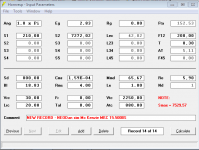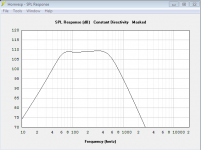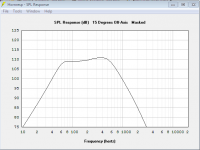Interesting subject! 🙂 I guess it will not influence my hornbuild very much though. Good idea to keep the frontplate of Ply for attachement.
Curious to what NEODan is coming up with next, what the horn will look like? I still can't really get how a shallow horn like that, can load that low. Would be interesting to discuss some theories about it.
Curious to what NEODan is coming up with next, what the horn will look like? I still can't really get how a shallow horn like that, can load that low. Would be interesting to discuss some theories about it.
Size Matters!
In Le Cleach's method, length is 'edge-traced' along the horn's profile; however, the axial length of the horn's extents (throat to mouth) should be held to >= c/(4*fl), where [fl] is the lowest frequency to be passed by the horn. To achieve this [fc] and [T] must be adjusted to yield a longer horn. It is the overall dimensions of the air column bounded by the horn that are the principal determinants of the low frequency performance of the horn, not its flare rate.
Regards,
WHG
Interesting subject! 🙂 I guess it will not influence my hornbuild very much though. Good idea to keep the frontplate of Ply for attachement.
Curious to what NEODan is coming up with next, what the horn will look like? I still can't really get how a shallow horn like that, can load that low. Would be interesting to discuss some theories about it.
In Le Cleach's method, length is 'edge-traced' along the horn's profile; however, the axial length of the horn's extents (throat to mouth) should be held to >= c/(4*fl), where [fl] is the lowest frequency to be passed by the horn. To achieve this [fc] and [T] must be adjusted to yield a longer horn. It is the overall dimensions of the air column bounded by the horn that are the principal determinants of the low frequency performance of the horn, not its flare rate.
Regards,
WHG
Ok, I understand the last part, but would you care to explain what c= in the formula?In Le Cleach's method, length is 'edge-traced' along the horn's profile; however, the axial length of the horn's extents (throat to mouth) should be held to >= c/(4*fl), where [fl] is the lowest frequency to be passed by the horn. To achieve this [fc] and [T] must be adjusted to yield a longer horn. It is the overall dimensions of the air column bounded by the horn that are the principal determinants of the low frequency performance of the horn, not its flare rate.
Regards,
WHG
Ok, I understand the last part, but would you care to explain what c= in the formula?
Hi sannax,
c is the velocity of sound in air - around 344 metres per second.
Kind regards,
David
Velocity of Sound
c = 34399 cm/sec in free air @ 20 ºC & 50% RH
Regards,
WHG
P.S., Hi David,
Did not see your post above,
Cheers,
Bill
Ok, I understand the last part, but would you care to explain what c= in the formula?
c = 34399 cm/sec in free air @ 20 ºC & 50% RH
Regards,
WHG
P.S., Hi David,
Did not see your post above,
Cheers,
Bill
Last edited:
So if the lowest frequency to be past by the horn is 60, then the axial horn lenght should be no less than = 34399/ 4*60= 143 cm. Right?
My last calculation shows the axial lenght of the horn is 43cm, but still the SPL shows a fairly good respons well below 100hz. Is real life different than Hornresp simulation?
At the same time LeCleach is "edge traced" along the the horns profile...what does this mean?
My last calculation shows the axial lenght of the horn is 43cm, but still the SPL shows a fairly good respons well below 100hz. Is real life different than Hornresp simulation?
At the same time LeCleach is "edge traced" along the the horns profile...what does this mean?
Dense, consistent composition of non-oriented wood fiber in a resin binder.
Higher internal damping and stiffer than plywood. See
MDF Board FAQ - Tutorial
for details.
All structures have resonances. In the case of loudspeaker enclosures, we raise their frequency by reinforcing panels across their longest span. Also we may pre-stress them as well (same as concrete). Laminar MDF construction, with pre-stressing threaded rods in tension make for an acoustically inert cabinet.
Regards,
WHG
MDF stiffer than plywood?
It`s the other way around, plywood is much stiffer than MDF.
My "sitting duck" mystake.
Easy target ;-).
WHG
MDF stiffer than plywood?
It`s the other way around, plywood is much stiffer than MDF.
Easy target ;-).
WHG
The Smell of Napalm
If you make the horn longer it will perform better at its LF limit. I am not about to be drawn into a contest about real vs. simulated worlds nor will I engage in arguments over minutiae.
The history of undersized, “honking” or otherwise “nasty sounding” horns is pervasive. So your too-short design will have lots of company. So, now on to
your "questions":
Rhetorical Question #1
Rhetorical Question #2
Rhetorical Question #3
Keeping with this vein, I have a question for you:
What do the words “past”, “horns”, “lenght” and “the the” mean?
WHG
If you make the horn longer it will perform better at its LF limit. I am not about to be drawn into a contest about real vs. simulated worlds nor will I engage in arguments over minutiae.
The history of undersized, “honking” or otherwise “nasty sounding” horns is pervasive. So your too-short design will have lots of company. So, now on to
your "questions":
Rhetorical Question #1
Wrong: Fc < FlSo if the lowest frequency to be past by the horn is 60, then the axial horn lenght should be no less than = 34399/ 4*60= 143 cm. Right?
Rhetorical Question #2
Maybe, but If Fl = 100 Hz., then Lx = 86 cmMy last calculation shows the axial lenght of the horn is 43cm, but still the SPL shows a fairly good respons well below 100hz. Is real life different than Hornresp simulation?
Rhetorical Question #3
Here is a clue: Ls > LxAt the same time LeCleach is "edge traced" along the the horns profile...what does this mean?
Keeping with this vein, I have a question for you:
What do the words “past”, “horns”, “lenght” and “the the” mean?
WHG
It's not the intention of the thread to start any contest about this. It's simply a question to know if what I see in Hornresp is what I can expect in real life. As it seems, it's not.If you make the horn longer it will perform better at its LF limit. I am not about to be drawn into a contest about real vs. simulated worlds nor will I engage in arguments over minutiae.
So Fc (system resonance) is lower than Fl (lowest frequency to be passed by the horn)? Care to explain in simple words?Wrong: Fc < Fl
I assume Lx is axial lenght?Maybe, but If Fl = 100 Hz., then Lx = 86 cm
Ls means? Is this a phrase within Hornresp? It's not easy to remenber them all in the beginning.Here is a clue: Ls > Lx
I do not follow? Are there any unclear things?Keeping with this vein, I have a question for you:
What do the words “past”, “horns”, “lenght” and “the the” mean?
If you make the horn longer it will perform better at its LF limit. I am not about to be drawn into a contest about real vs. simulated worlds nor will I engage in arguments over minutiae.
The history of undersized, “honking” or otherwise “nasty sounding” horns is pervasive. So your too-short design will have lots of company. So, now on to
WHG
So what is this about horn honk the unmeasurable phenomenon?
 Do tell.
Do tell.It's interesting how you attack an example that is made with a tool that is built from the same maths that all "classical" assumptions about horn performance are made. Do you ever stop to think that possibly you don't recall all the rules or variables that the software does? It's kind of like only using the hypex calculator in Hornresp, sure you get a "propper" horn. And then learning to actually use Hornresp as a tool for the art of speaker design, totally different probably better result for what the designer intended. My little horn has less directivity because I wanted it that way for smoother polars, smaller size...
Different opinions here I can see. You are all velcome to discuss those topics here. I am trying to understand all of this, hence my questions about simulations and real life.
Has anyone actually built and listened to such a horn?
NEODan: I have simulated the parameters you sent me (thanks!), but they all seems to end up being 130cm (if y=radius, when exporting data?) and up in diameter. I can stretch it to 100cm, but not very much bigger because of roomsize. 90 to 95cm would be best. Not sure if it is even possible with this kind of LeCleach. I have tried to change T, S1, T12 in some simulations, but then again it suddenly looks like a hypex horn with no rollback.
Has anyone actually built and listened to such a horn?
NEODan: I have simulated the parameters you sent me (thanks!), but they all seems to end up being 130cm (if y=radius, when exporting data?) and up in diameter. I can stretch it to 100cm, but not very much bigger because of roomsize. 90 to 95cm would be best. Not sure if it is even possible with this kind of LeCleach. I have tried to change T, S1, T12 in some simulations, but then again it suddenly looks like a hypex horn with no rollback.
Last edited:
To optimize for smaller size is not a problem. What are your prefrences for off axis optimization? it looks like beyond ~+- 25 degrees is stretching it. I will make the Fta 120 degrees, but it would be best if not placed directly on the floor, a gap of 20-30cm would be good. I think the AG stuff is like this too? With this in mind what is the limit on diameter?
Hi Dan,
Just a word of caution - by using Ang =1.0 x Pi you have assumed that the horn is tightly coupled in a wall / floor position and is radiating into quarter space only. This is unlikely to be the case in practice for a fully-formed mid / upper bass axisymmetric Le Cléac'h horn having a mouth Fta of 180 degrees.
In the circumstances it may be safer to assume a solid radiation angle of 2 Pi, or perhaps even 4 Pi just to be sure.
Kind regards,
David
Thanks again for posting this David.
I think what David is getting at here is that the Fta 180 is not well suited for use near boundarys as that would take away from how the roll back loads the horn. In thinking about this and how the full roll back must provide a higher impedance to acheive more horn loading it is probably not good to take a round horn and plunk it down near the floor as the boundary will probably take your perfect round horn and effectively - virtually chop a big chunk of it away.
I had not designed my horn to be round. For me I am thinking I will still try a floor loaded horn but I will not have the full roll back.
I am thinking about this form with the flat bottom:

More
It provides an approximation of frequency response, not distortion products that occur, particularly when the driver becomes un-loaded by a short horn.
[Fc], horn cutoff frequency, determines m = 2*pi()*fc/c the flare coefficient.
In theory, [Fc] represents the frequency below which the horn will not radiate acoustic energy.
System resonant frequency is normally set higher than [Fc]. A longer horn (and enclosed air column), brings this down with additional mass loading of the driver.
Yes
[Ls] stands for the length of the curve that forms the horn boundary. It includes the length of the curled back lips as well.
Only intent was unclear here. The question is a rhetorical one.
Regards,
WHG
It's not the intention of the thread to start any contest about this. It's simply a question to know if what I see in Hornresp is what I can expect in real life. As it seems, it's not.
It provides an approximation of frequency response, not distortion products that occur, particularly when the driver becomes un-loaded by a short horn.
So Fc (system resonance) is lower than Fl (lowest frequency to be passed by the horn)? Care to explain in simple words?
[Fc], horn cutoff frequency, determines m = 2*pi()*fc/c the flare coefficient.
In theory, [Fc] represents the frequency below which the horn will not radiate acoustic energy.
System resonant frequency is normally set higher than [Fc]. A longer horn (and enclosed air column), brings this down with additional mass loading of the driver.
I assume Lx is axial lenght?
Yes
Ls means? Is this a phrase within Hornresp? It's not easy to remenber them all in the beginning.
[Ls] stands for the length of the curve that forms the horn boundary. It includes the length of the curled back lips as well.
I do not follow? Are there any unclear things?
Only intent was unclear here. The question is a rhetorical one.
Regards,
WHG
False Premises and Tangential Arguments
4) It is a simulation tool not a measurement tool and detailed horn resonances are not shown nor is that function required to meet the design mission.
6) Le Cleach's method foreshortens an otherwise longer Salmon horn; therefore, [fc] over states the LF performance of the horn so designed.
WHG
1) That is entirely you assertion. I made no such claim of immeasurability. If a horn honks you can measure it. A spectrum analyzer will surface it immediately when input and output signals are compared. You also can just avoid horn honk altogether by good horn design. Of course the same tool can be used to design both. For horns, size matters.So what is this about horn honk the unmeasurable phenomenon?Do tell.
3) Attack is your characterization of my recommendation to make a particular horn longer. Yet again another false assertion is made here.It's interesting how you attack an example that is made with a tool that is built from the same maths that all "classical" assumptions about horn performance are made.
4) It is a simulation tool not a measurement tool and detailed horn resonances are not shown nor is that function required to meet the design mission.
5) A large number of design variables is not at issue here, just horn length and its relation to the wave length of [Fl].Do you ever stop to think that possibly you don't recall all the rules or variables that the software does?
6) Le Cleach's method foreshortens an otherwise longer Salmon horn; therefore, [fc] over states the LF performance of the horn so designed.
7) Like a hammer, it is a tool that won’t prevent bent nails.It's kind of like only using the hypex calculator in Hornresp, sure you get a "propper" horn. And then learning to actually use Hornresp as a tool for the art of speaker design, totally different probably better result for what the designer intended.
8) You can of course raise [Fl] well above [Fc] so that horn length is not at issue, and you can set priorities differently in the design tradeoffs that will need to be made.My little horn has less directivity because I wanted it that way for smoother polars, smaller size...
WHG
To optimize for smaller size is not a problem. What are your prefrences for off axis optimization? it looks like beyond ~+- 25 degrees is stretching it. I will make the Fta 120 degrees, but it would be best if not placed directly on the floor, a gap of 20-30cm would be good. I think the AG stuff is like this too? With this in mind what is the limit on diameter?
It looks like AG has some 10-20cm gap above the floor. Off axis optimization is not that crucial, but off course, I will use the horns for cinema too, so it would be nice that the sweetspot is not narrowed to much (if this is what you are thinking off with off-axis...the response?)
The limit of diameter, when raising it 20cm up from the floor, would the be not more than 95cm. That said, I don't have to have LeCleach with the 180 roll back in this particular horn. It is more important to have a LF respons down to 80hz, so that I can integrate with my LF bass channels (subs if you will).
It may seem difficult to achieve, and if it is easier to use a hypex (feks.) I will rather do that. Seems people are satisfied with those horns as well. It's all about compromises right? It may be ok to choose the best compromises though.
- Status
- Not open for further replies.
- Home
- Loudspeakers
- Multi-Way
- Hyperbolic mid/upper bass horn


